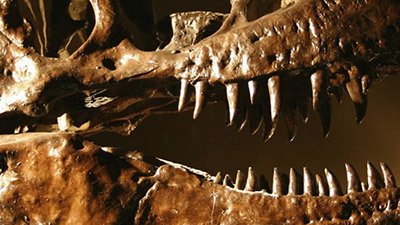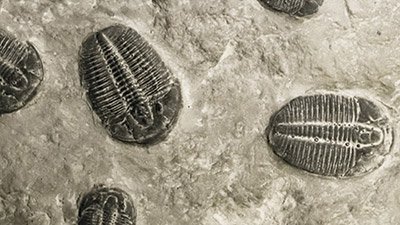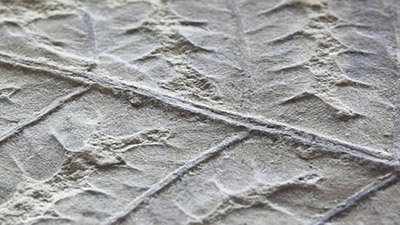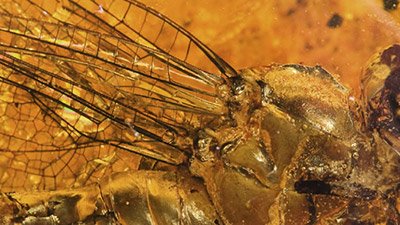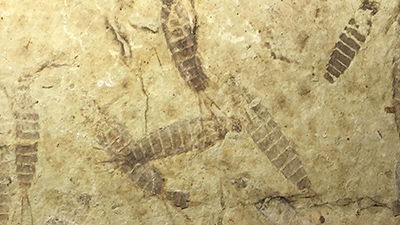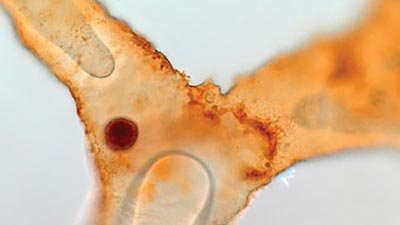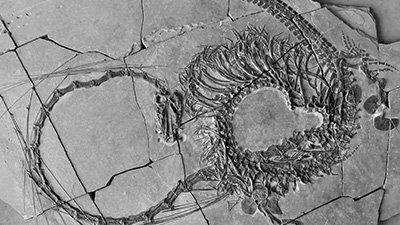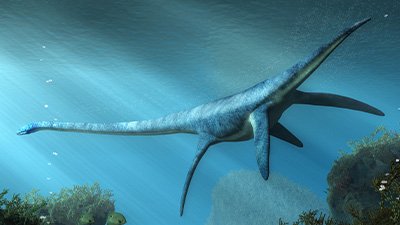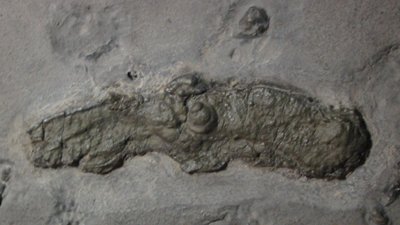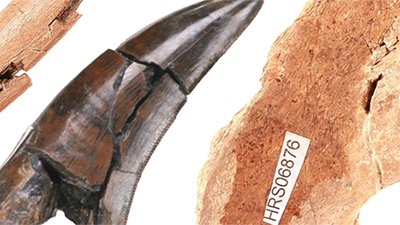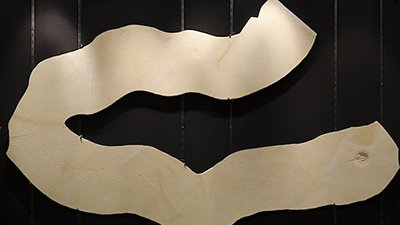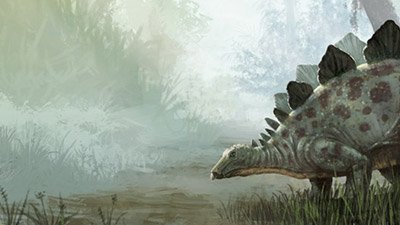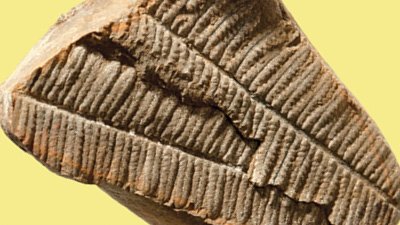Fossils
Throughout the world’s rock layers there are billions of fossils, the remains of organisms that were catastrophically buried largely during the global Flood (2348 BC). Understandably the vast majority of these are marine creatures and they were buried quickly and sequentially by habitat.
From Check This Out
Purchase the full Check This Out! video
The Making of a Fossil
Do fossils require millions of years to form? Hardly! Even secular geologists now recognize that rocks form very quickly.
Fossils of Dinosaur National Monument
Each visitor to Dinosaur National Monument sees the same evidence—massive amounts of dinosaur (and other) fossils all jumbled together. How one explains the formation of this fossil bed depends on one’s worldview. When viewed from a biblical perspective, the evidence is consistent with what one would expect from a worldwide Flood.
Putting Fossils Back Together
This research reminds us of the caution we should accord to every fossil reconstruction. Especially when it comes to supposed “ape-men” like Lucy, Ardi, and others, we must be aware of the fact that evolutionary ideas may be (consciously or subconsciously) guiding the reconstruction.
Five Fossil Mysteries
We can never answer all the questions. But with practice at “fossil sleuthing” from a biblical perspective, at least we can get better and better at evaluating each new discovery in a God-honoring way that might yield new insights into God’s person and work.
Fossils Topics
-
Dinosaur Bones
The presence of soft tissue in dinosaur bones cries out for a young earth, not for millions of years. These not-so-dry bones support the Bible’s history!
-
Dinosaur Footprints
Dinosaur bones aren’t the only artifacts left behind by these creatures. Fossilized footprints point toward the watery cataclysm that buried the dinosaurs.
-
Fossil Record
The fossil record, billions of dead things buried in rock layers laid down by water all over the earth, is dramatic evidence of the historicity of Noah’s Flood.
-
How Are Fossils Formed?
Do fossils really require millions of years to form? The evidence shouts no! A lot of water and a little bit of time rapidly laid down the fossil record.
-
Living Fossils
Living fossils, organisms previously known only through the fossil record and having no close living relatives, pose a grim threat to the evolutionary paradigm.
-
Transitional Fossils
Evolution predicts a fossil record bursting with transitional fossils. Curiously, there are only a handful of highly-disputed fossils that are claimed as such.
-
Types of Fossils
The fossil record shows more biodiversity than our current ecosystems. This incredible diversity clearly demonstrates the handiwork of the Creator!
News About Fossils
-
Dec. 8, 2025 from Ken Ham Blog
In the frigid Canadian Arctic Circle, researchers have found a nearly complete fossil of a new rhinoceros species, Epiatheracerium itjilik.
-
Aug. 14, 2025 from Ken Ham Blog
Another ichthyosaur fossil is confirming the truth of rapid burial.
-
July 19, 2025 from Ken Ham Blog
The headline of a popular science summary of the paper reads, “Dinosaur wrist bone discovery reshapes understanding of flight evolution.”
-
June 20, 2025 from Ken Ham Blog
Which came first—the butterfly or the flower? Evolutionary ideas claim the butterfly existed long before flowering plants, but does this make the best sense of the evidence?
Articles About Fossils
-
Nov. 16, 2025 from Answers Magazine
Anyone who doubts there was once a “lost world” during the ice age simply needs to visit the La Brea Tar Pits in downtown LA.
-
Jan. 1, 2025 from Answers Magazine
When we start with the history in Genesis, Christians can explain fossils without fear.
-
Oct. 1, 2024 from Answers Magazine
A parasite preserved in amber (fossilized tree resin) has scientists scratching their heads—because it is a shark parasite.
-
April 1, 2024 from Answers Magazine
Soft tissue poses a problem for evolutionists—but it confirms the biblical timeline.
-
Jan. 1, 2023 from Answers Magazine
Paleontologists have dusted off 45 new dinosaur species every year since 2003, and many of these discoveries unearthed dinosaurs with especially unique features.
-
Aug. 14, 2022 from Answers Magazine
In a few rare spots, geologists find fossils of strange eight-foot-tall “mushrooms.” What do they tell us about the mysterious world they came from?
-
July 18, 2021 from Answers Magazine
Ask the average layperson how he or she knows that the earth is millions or billions of years old, and that person will probably mention the dinosaurs.
-
March 7, 2021 from Answers Magazine
The fine details preserved in fossils mystify evolutionists but not paleontologists who believe in the Genesis flood.
-
March 1, 2020 from Answers Magazine
Putting together the pieces of this puzzle points to the cataclysmic events of the global flood.
-
Jan. 1, 2020 from Answers Magazine
Evolutionists like to talk about change, so how do they explain so many living creatures that look like their fossilized ancestors?
-
Nov. 1, 2019 from Answers Magazine
Horseshoe crabs are called “living fossils” because the ones you see in aquariums today look the same as their ancestors deep in the fossil record.
-
Jan. 18, 2019 from Answers in Depth
The hoatzin is a very unique bird, a conglomeration of traits typical of birds, reptiles, and mammals. Its most unique features are distinctly un-birdlike.
-
Oct. 16, 2018 from Answers in Depth
Ichthyosaurus is well studied, and research on their skeletons has provided evidence for incredible design and the global flood.
-
March 21, 2017 from Answers in Depth
Saccorhytus is, the authors believe, the oldest and simplest known deuterostome, the evolutionary forebear of all vertebrates and some invertebrates.
-
Oct. 20, 2016 from Answers in Depth
Despite a large body of evidence for the authenticity of the dinosaur tissue, there remains a pattern of denial within the evolutionist community.
-
Oct. 1, 2016 from Answers Magazine
Beautifully preserved fossils are so common that we overlook how unusual they are.
-
June 28, 2016 from Answers in Depth
Animals can show up in the oddest places and make evolutionists scratch their heads as is the case with the newly discovered monkey fossils.
-
Book Chapter3.1 The Fossil Evidence—IntroductionMarch 28, 2016 from Creation: Facts of Life
Can changes from molecules-to-man (macroevolution) be explained by (extrapolated from) the process of mutation-selection (microevolution)?
-
In-Depth ArticlePreserved Cretaceous Collagen and Dinosaur Blood: Common Clues to a Catastrophic Past?June 22, 2015 from Answers in Depth
Evolutionists have come to largely accept the fact that soft tissues can be preserved in fossils for an extraordinarily long time. But millions of years . . . ?
-
Magazine Department ArticleGrounds for ReevaluationApril 1, 2015 from Answers Magazine
The fossil of a creature resembling a groundhog that lived during the time of dinosaurs has become an anomaly for evolutionists.
-
Magazine Department ArticleI Must Go Down to the Seas AgainApril 1, 2015 from Answers Magazine
Cartorhynchus lenticarpus, whose discovery was hailed last November, is being hailed as an evolutionary link, but this characterization is premature.
-
In-Depth ArticleWill Fish Fossil Change Evolutionary Tree?Feb. 7, 2015 from Answers in Depth
Did jawed vertebrates start out with bones or not? Evolutionists want to know.
-
Sept. 18, 2014 from Answers in Depth
Massive Dreadnoughtus said to shed light on the evolution of gigantism.
-
In-Depth ArticleDid All Dinosaurs Have Feathers?Aug. 2, 2014 from Answers in Depth
Get used to seeing feathers on all evolutionary depictions of dinosaurs, not just theropods!
-
In-Depth ArticleThirty Million Years Didn’t Really Change China’s Jurassic ParkMarch 8, 2014 from Answers in Depth
China’s Jurassic fossils get a new name.
-
3D Fossil Images Force Evolutionists to Revise Terrestrial StoryJan. 19, 2013 from News to Know
Three-dimensional images of fossil will force evolutionists to revise their terrestrial story, but not much.
-
Pinpointed Origin of IntelligenceDec. 8, 2012 from News to Know
Evolutionary researchers claim to have pinpointed the origin of intelligence.
-
-
Orphan Eggs Offer Clues to Missing ParentsApril 14, 2012 from News to Know
Orphan eggs in Cretaceous Spain offer ambiguous clues to their missing parents.
-
Common Ancestor Hidden in Burgess ShaleMarch 10, 2012 from News to Know
Burgess Shale said to shelter “the most primitive known vertebrate and therefore the ancestor of all descendant vertebrates, including humans.”
-
Which Version of History Do Fossils Reflect?March 10, 2012 from News to Know
Fossil diversity “accurately reflects history”—but which version of history?
-
-
Classifying the Blue Whale by Jaw TypeAug. 27, 2011 from News to Know
Another big mouth beast becomes an honorary member of the baleen club.
-
-
Lizard Found Trapped in AmberOct. 30, 2010
We’ve all seen photographs of insects, arachnids, and other small creatures trapped in amber. But a lizard?
-
Oldest Found Remains of AnimalsAug. 21, 2010
Last week it was the oldest remains of the earth. This week, it’s the oldest remains of animals.
-
Jigsaw Puzzle ChallengeDec. 5, 2009 from News to Know
Reassembling half-billion-year-old fossils from bone fragments: a task so complicated that only computers can handle it?
-
18-Million-Year-Old MuscleNov. 14, 2009 from News to Know
Fossilized soft tissue has been found in a salamander fossil said to be 18 million years old.
-
Prehistoric InkAug. 22, 2009 from News to Know
Scientists cannot only write about amazing fossil discoveries; now, they can write with one!
-
Book ChapterDinosaur National Monument in UtahJuly 31, 2008 from Wonders of Geology
Dinosaur National Monument houses one of the largest on-location dinosaur fossil displays in the entire world.
PDF Download -
An Example of Circular ReasoningJune 4, 2007 from Responding to Protestors’ Propaganda
The fossil record is more like a record of the effects of sin when the Flood demolished the vast majority of life on earth, creating massive fossil graveyards.
-
Magazine ArticleDead Whales: Telling Tales?Sept. 1, 2004, pp. 10–14
“We knew it was a great find,” said paleontologist Leonard Brand about the fossil whales he saw in Peru in 1999, 350 km (200 miles) south of Lima, the capital.
-
Semi-Technical Research PaperA Uniformitarian Paleo-Environmental Dilemma at Clarkia, Idaho, USAApril 1, 2002, pp. 3–4
A farmer digging a snowmobile course accidentally unearthed one of the most remarkably-preserved plant fossil localities in the world.
-
Technical Research PaperFish Preservation, Fish Coprolites and the Green River FormationApril 1, 2001, pp. 105–111
Uniformitarian models fail to explain the remarkably well-preserved fish fossils in the Green River Formation, Wyoming, USA.

Answers in Genesis is an apologetics ministry, dedicated to helping Christians defend their faith and proclaim the good news of Jesus Christ.
- Customer Service 800.778.3390
- Available Monday–Friday | 9 AM–5 PM ET
- © 2025 Answers in Genesis


